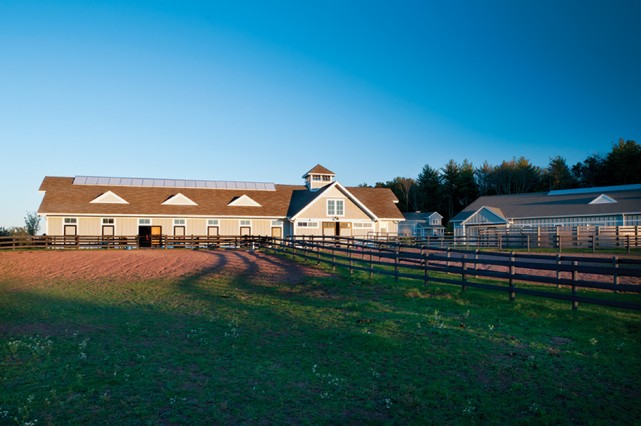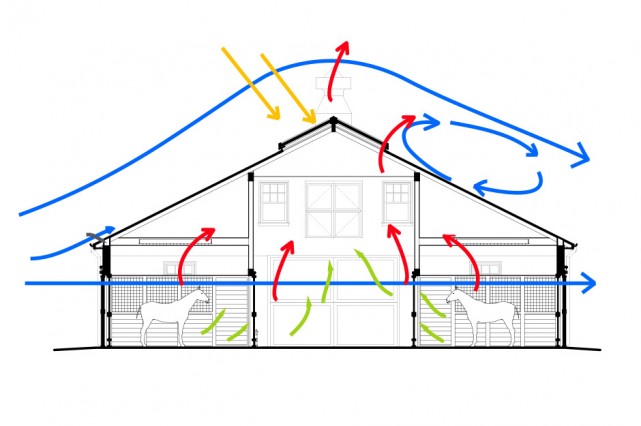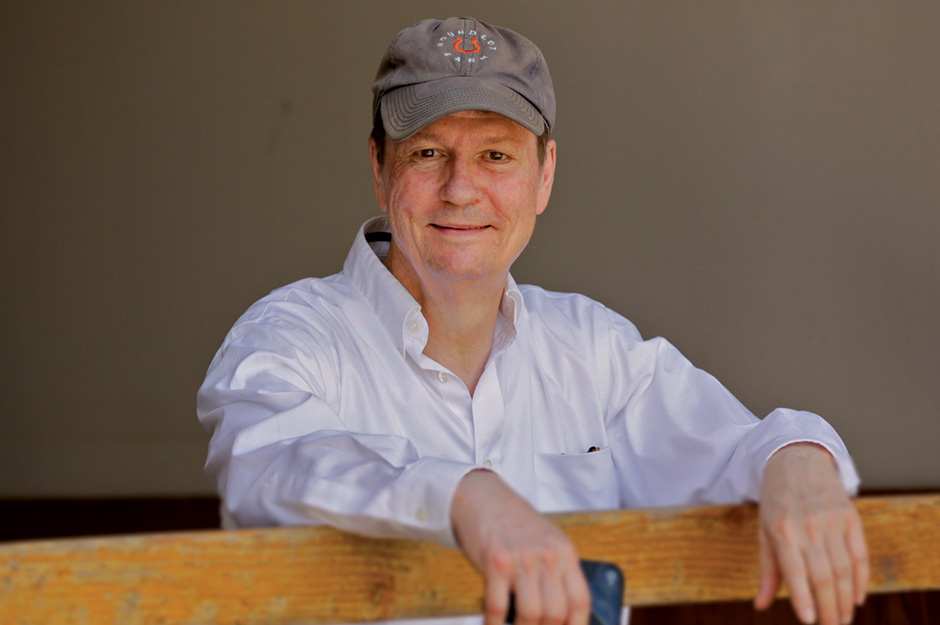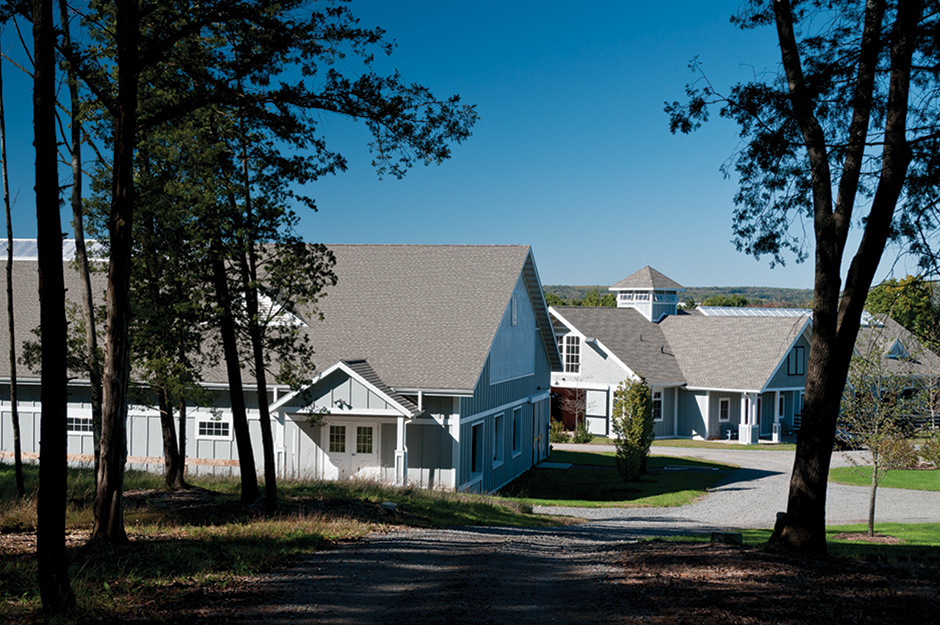Barn Design Masterclass with America’s Top Equine Architects: EQ visits Great Road Farm, near Princeton, N.J. with John Blackburn.
Published Fall 2013
A family desired a different kind of life for themselves and their four sons, and chose to move to the Princeton, N.J., area. The husband favored a life of farming and food, went to culinary school and worked for a top New York restaurant before opening his own farm-to-table eatery. The wife sought to parlay her expertise in social work into a therapeutic riding facility on their new farm. Blackburn was chosen to create a 12-stall barn for hunter jumpers and indoor and outdoor riding arenas, which would do double duty for family and friends as well as accommodate disabled students.
No matter one’s budget, what are the imperatives in barn and farm design?
The health and safety of the horse is always my first concern. After that, one needs to balance the demands of the site (identifying its unique qualities and limitations) with the owner’s goals for the property. Keeping these three concerns in mind (horse, site, owner), we then start working through the requirements and budget to design an affordable and efficient stable.
Not everyone is able to build a farm like some of the luxurious properties in EQ. How can working with an architect help you achieve the best possible result within a budget?
There are three ways to build a barn. You can buy a pre-fab barn and have it delivered to the site; you can retain a design/build firm to build a barn; or you can hire an equestrian architect to design a barn. The reason you choose an architect is because they are your advocate in getting your dream barn and in planning the farm. The first two are simply selling a product, while the architect is providing you a service. An equestrian architect understands the needs of your horses and the operational needs of the farm. Working with someone who has experience is the best way to achieve the best possible result within the limits of your budget. I have seen a lot of very expensive barns that are unsafe and inefficient because the designer did not understand the needs of the horse or farm. Spending to hire an equestrian architect with experience instead of pursuing the prefab or design/build approach can end up saving you operational and upkeep costs.

Where are the best places to save?
The first priority is site planning and the selection of your building site. Not many farms are developed all at once. Site plans allow you to phase your buildings, maximize the potential of the site, and minimize land improvement costs, or at least phase them over time. Proper planning can ensure that 5, 10, or 20 years down the line you won’t need to tear down something because it was put in the wrong place. Ultimately, it should help save you money and headaches in the long run.
I once had a potential client call and ask me to design an indoor arena for her. She had recently bought a pre-fab barn and erected it where she thought best. A year later when she was ready to construct her arena, she realized that she placed the barn exactly where the arena should be. This is an example of where a little planning by an experienced professional could have provided a better and more economical solution in the long run.
How do you decide building placement?
The placement of the barn plays a major impact on ventilation. Here at Great Road Farm, the positioning of the barn is basically perpendicular to the prevailing westerly summer breeze.
The reason is that the air from inside the barn is vented out through the triangular, louvered roof vents, the continuous vent along the base of the ridge skylight, and the ridge of the skylight itself. Vertical ventilation is achieved by the positioning of the barn, the placement of the openings and also by the Bernoulli principle. That means the prevailing winds blowing over the roof and the angle of the roof accentuates the difference in high and low-pressure areas on opposite sides of the roof. Similarly to how the low pressure created by the shape of an airplane wing is what gives an airplane lift, the reduced pressure on the leeward side pulls the air out of the barn through the openings in the roof. The natural ventilating is augmented and supported by a chimney effect (hot air rises). The vertical ventilation rids the barn of the odors, pathogens, and infectious bacteria that could otherwise be transported from horse to horse by horizontal fans.

What about the positioning of the other buildings?
The positioning of all of Great Road’s buildings was carefully planned. The barn, arena, and service buildings each are sited based on their function and how they will work together most efficiently and safely. For example, we wanted to provide privacy for the residential portions of the farm, minimize the penetration of service vehicles into the site, and save workers’ footsteps with an optimum workflow.
An important aesthetic consideration is to keep the buildings at a unified visual scale. Arenas are often huge, ugly structures, dwarfing a property’s barn and other buildings. Here, we recessed the arena into a natural slope to reduce the mass of the building as it is seen from the road. It has also been pushed to the edge of the forested portion of the site, which further helps reduce its perceived size and conceals the bulk and length of the structure as one drives down the entry drive.
We can’t help but be amazed by the light as you enter these buildings.
Both the barn and the arena are designed to function throughout the day without the use of artificial lighting, except in enclosed rooms such as a bathroom or laundry. The arena has perimeter openings, glazed gable ends, and a ridge skylight as well. The glazing is poly-carbonate panels that are low cost, shatterproof for safety, and translucent to break up the light, to eliminate harsh shadows that horses could tend to jump.
Natural light and ventilation saves money and makes barn time more enjoyable, too.

A barn is typically a static structure requiring artificial wind (fans) and artificial lighting (electric lights). Designed properly, a barn becomes a machine that creates its own wind, or at the very minimum, ventilation, and light naturally.
Any other interesting features in working within a budget at Great Road?
By choosing lesser quality finish materials we were able to spend less money but still retain a polished look. Even though the finish materials may differ from some of our higher-end barns, the same attention was paid to designing for the health and safety of the horse. I frequently tell my clients that it is not the horse asking for oak paneling or fancy finishes.
This property is in New Jersey. How does the location, use of the property, and the number and type of horses affect the design?
One example of how the number and type of horses affects design is in regards to turnout space. The number of horses on the property is important because it affects the amount of space needed for paddocks and grazing and other functional needs (arenas, gallop trails, etc). Additionally, your location plays a factor. For example, in the dry climate of west Texas, you need more acreage per horse than the rich soil of Kentucky.
Different disciplines require different needs in terms of turn-out space. For example, polo ponies are typically turned out for the majority of the off-season in a herd, while they are kept in barns frequently during polo season. Their farm paddock layout would be different than a breeding operation, which needs to isolate stallions from each other, but can turn out the broodmares in a herd. The training operations that turn out horses for a few hours a day require different size and layout of paddocks than a farm that leaves their horses out all day. This is one of the reasons why each barn, site, and owner’s needs are different. There isn’t one ultimate barn, just as there is not one ultimate farm layout, that will fulfill all needs, but an equestrian architect can design a barn or farm that will be that particular site’s and client’s “ultimate” barn.
What advice would you give someone who is planning a facility?
First, before buying the land, ask an equestrian architect with experience to come see it. The architect can help you decide if the land is a good investment because they have experience with a wide variety of site conditions that can impact the usability of the land. They are familiar with zoning and building codes and will be able to recognize unique features and land characteristics that provide distinctive features. No one wants to buy a new property and hear that they need to invest a vast sum of money in the site before they can even consider building the barn. By bringing in an equestrian architect early, an owner can avoid getting too “invested” in a property or project and having to cut back, phase or abandon a project altogether.
Working with an equestrian architect who has experience understanding your budget, goals, and business plan will be able to provide an end result that you can be happy with and enjoy, while your horses are healthy and safe.

John Blackburn’s architectural firm, based in Washington, D.C., has become one of America’s best known specializing in equestrian projects, from site planning through design and construction management. A book on John’s work, Healthy Stables By Design, was just released. All profits from the sale of the book will be donated to horse charities.

